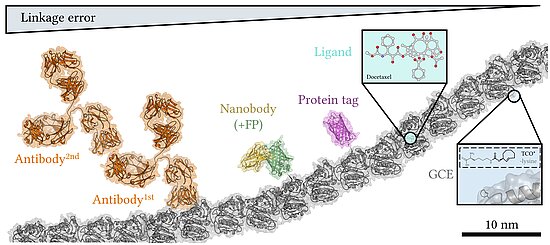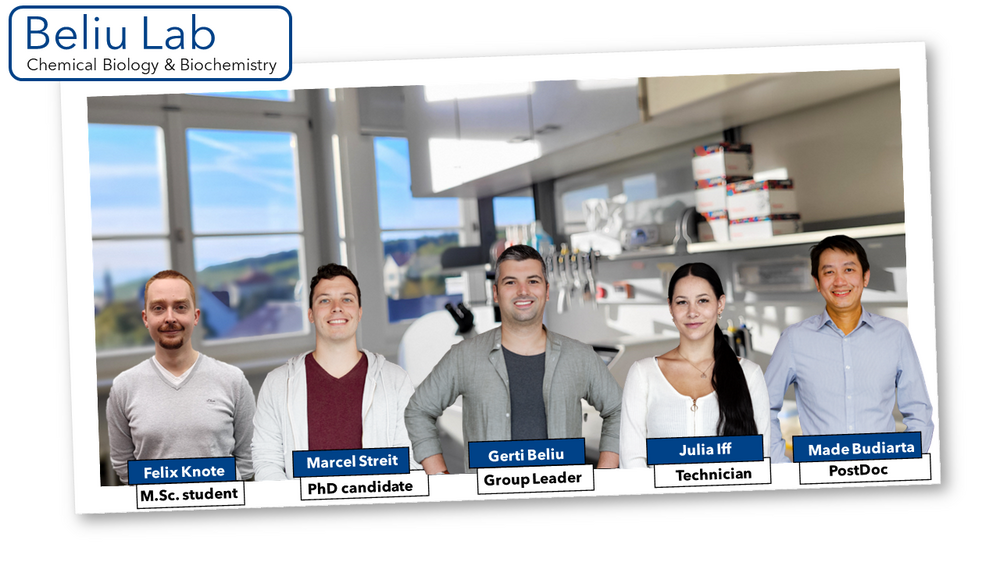Beliu Group
Previous and current research
The fundamental challenge of modern super-resolution microscopy is to combine highest localization precision using synthetic fluorophores with highest localization accuracy using genetically encoded and/or chemically-coupled tags. However, biological function is often perturbed when biomolecules are labeled with fluorescent markers and thus still limit molecular resolution bioimaging in real biological samples such as living cells.
To realize the full potential of super-resolution imaging at the nanoscale, we utilize novel biochemical compounds for our super-resolution toolbox to push the structural resolution and experimental robustness. Minimal linkage errors (e.g. via click chemistry and peptide-tags for site-specific protein tagging) and fluorogenicity together with live-cell compatibility result in stoichiometric fluorescence labeling at site-specific positions without altering biological function.
Future Research Goals
Building biochemical tools for biomedical applications
Bioorthogonal reactions can be performed under physiological conditions while retaining excellent chemoselectivity and host orthogonality even in complex environments or targets such as cells, tissues or organism and are therefore of outmost interest for biomedical applications. With the upcoming application of click activated prodrugs against cancer in humans, we plan to develop, characterize and use these novel compounds in close collaboration with biomedical groups at the University of Würzburg for application in medical treatment and translational bioimaging.
Molecular resolution bioimaging
Molecular labeling is the basis of molecular fluorescence imaging. By using fluorogenic and photoswitchable fluorophores in combination with latest gene-editing and microscopic tools (e.g. Expansion microscopy) we will enable real quantitative bioimaging with ~1-5 nm structural resolution.
Additionally, we will construct precise reference structures (such as DNA origamis and defined polypeptides) as molecular rulers, with minimal spatial requirements and multiple colours, for validation of the applied microscopy techniques. These novel tools can directly be transferred to existing super-resolution approaches and will be made available for colleagues and collaborators.
Publications on Google Scholar: https://scholar.google.com/citations?user=3FtVCN8AAAAJ&hl=de&oi=ao
P. Eiring, R. McLaughlin, S. Matikonda, H. Zhongying, L. Grabenhorst, D. Helmerich, M. Meub, G. Beliu, M. Luciano, V. Bandi, N. Zijlstra, Z. Shi, R. Swenson, P. Tinnefeld, V. Glembockyte, T. Cordes, M. Sauer, M. Schnermann. “Targetable Conformationally Restricted Cyanines Enable Photon-Count Limited Applications”. Angewandte Chemie (2021). doi: https://doi.org/10.1002/anie.202109749.
D. Bessa-Neto#, G. Beliu#, A. Kuhlemann#, S. Doose. V. Pecoraro, N. Chevrier, D. Perrais, M. Sauer, D. Choquet. “Bioorthogonal labeling of transmembrane proteins with non-canonical amino acids allow access to masked epitopes in live neurons”. Nature Communications (2021). doi: https://doi.org/10.1038/s41467-021-27025-w.
Kuhlemann#, G. Beliu#, D. Janzen, E. Petrini, S. Doose, M. Bruno, A. Barberis, C. Villmann, M. Sauer, C. Werner. “Genetic code expansion and click-chemsitry labeling to visualize GABA-A receptors by super-resolution microscopy”. Frontiers in Synaptic Neuroscience (2021). doi: https://doi.org/10.3389/fnsyn.2021.727406.
M. Lelek, M. Gyparaki, G. Beliu, F. Schueder, J. Griffié, S. Manley, R. Jungmann, M. Sauer, M. Lakadamyali, C. Zimmer. “Single-molecule localization microscopy”. Nature Reviews Methods Primer (2021) doi: https://doi.org/10.1038/s43586-021-00038-x
S. Matikonda, D. Helmerich, M. Meub, G. Beliu, P. Kollmannsberger, A. Greer, M. Sauer, M Schnermann. “Defining the Basis of Cyanine Phototruncation Enables a New Approach to Single-Molecule Localization Microscopy”. ACS Central Science (2021) doi: https://doi.org/10.1021/acscentsci.1c00483
D. Helmerich#, G. Beliu#, S. Matikonda, M. Schnermann, M.Sauer. “Photoblueing of organic dyes can cause artifacts in super-resolution microscopy”. Nature Methods (2021) doi: https://doi.org/10.1038/s41592-021-01061-2
G. Beliu#, S. Altrichter#, R. Guixà-González#, M. Hemberger, I. Brauer, A. Dahse, N. Scholz, R. Wieduwild, A. Kuhlemann, H. Batebi, F. Seufert, G. Pérez-Hernández, P.W. Hildebrand, M. Sauer, T. Langenhan. “Tethered agonist exposure in intact adhesion/class B2 GPCRs through intrinsic structural flexibility of the GAIN domain”. Molecular Cell (2021) doi: https://doi.org/10.1016/j.molcel.2020.12.042
D. Helmerich, G. Beliu, M.Sauer. “Multiple-Labeled Antibodies Behave Like Single Emitters in Photoswitching Buffer”. ACS Nano (2020), doi: https://doi.org/10.1021/acsnano.0c06099
G. Beliu and M.Sauer. “A Trojan Horse for live-cell super-resolution microscopy”. Light, science & applications (2020), doi: https://doi.org/10.1038/s41377-019-0238-7
G. Beliu, A. Kurz, A. Kuhlemann, L. Behringer-Pliess, M. Meub, N. Wolf, J. Seibel, Z. Shi, M. Schnermann, J. Grimm, L. Lavis, S. Doose, M. Sauer. “Bioorthogonal labeling with tetrazine-dyes for super-resolution microscopy”. Communications Biology (2019) doi: https://doi.org/10.1038/s42003-019-0518-z
F. Neubert#, G. Beliu#, U. Terpitz, C. Werner, C. Geis, M. Sauer, S. Doose. “Bioorthogonal Click Chemistry Enables Site‐specific Fluorescence Labeling of Functional NMDA Receptors for Super‐Resolution Imaging”. Angewandte Chemie (2018) doi: https://doi.org/10.1002/anie.201808951
Dr. Gerti Beliu
Josef-Schneider-Str.2
Marcel Streit
Josef-Schneider-Str. 2
Julia Iff
Josef-Schneider-Straße 2
Dr. Made Budiarta
Josef-Schneider-Str. 2
CV
09/21 | Junior Group Leader at the Rudolf Virchow Center (RVZ) University of Würzburg |
| 01/20 - date | Postdoctoral Researcher, University of Würzburg, Germany “Biochemical tools for fluorescence labeling and super-resolution fluorescence microscopy” |
| 09/15 – 01/20 | PhD (Dr. rer. nat.) in Biology, University of Würzburg, Germany (awarded with ‘summa cum laude’) |
| 10/10 – 08/15 | Bsc & MSc in Biology, University of Würzburg, Germany |




